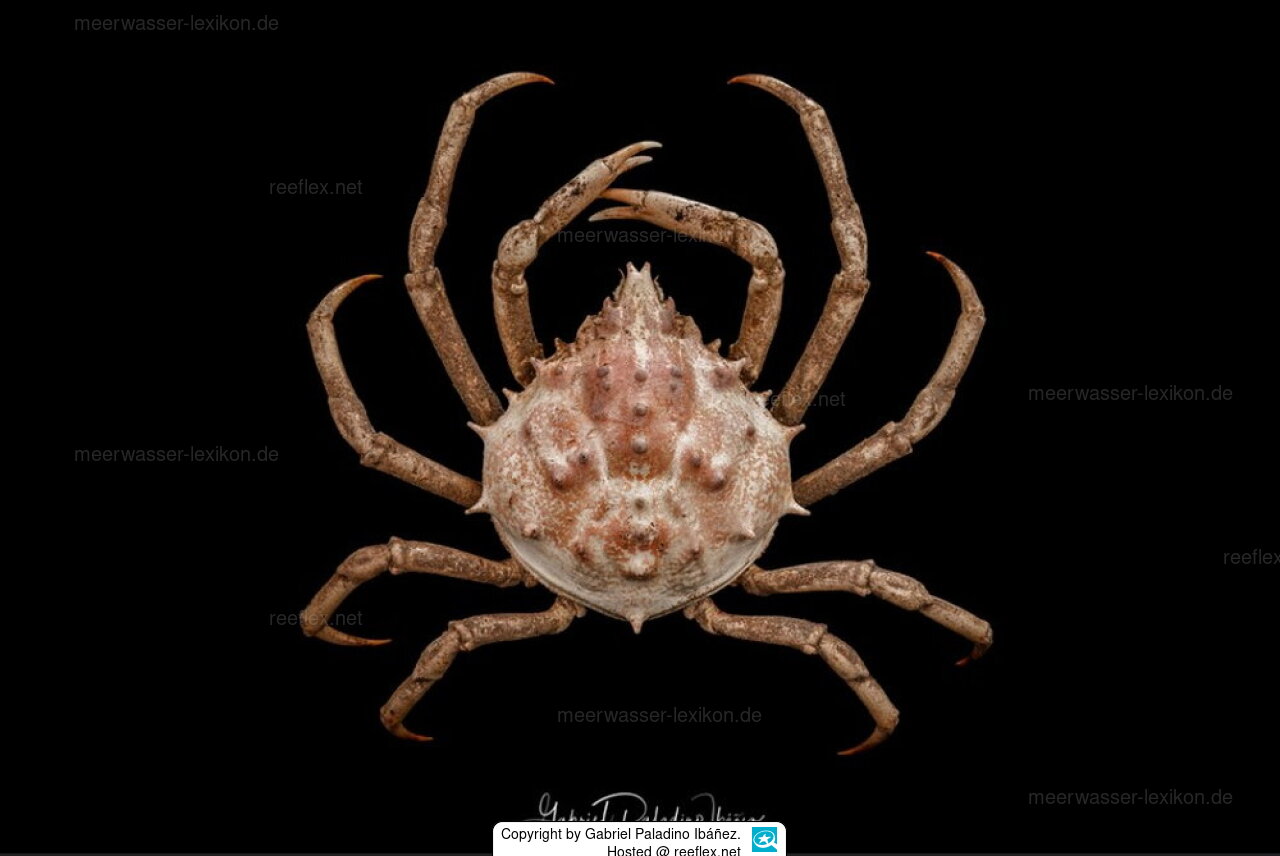Info
Libinia spinosa Guérin, 1832
The carapace is up to 89 mm long and the leg span can be up to 568 mm. The number of central spines of Libinia spinosa can vary, with 7 being the most common number, although specimens with 5, 8 and 10 central spines also occur.
Libinia spinosa is native to mud and sandy soils in the southwest Atlantic and Pacific Oceans. It feeds on a wide range of foods such as algae, sponges, cnidarians, molluscs, polychaetes, crustaceans and small fish.
It often enters into a symbiotic relationship with the medusa Lychnorhiza lucerna, especially in its juvenile stage. It preys on mobile as well as sessile organisms. Libinia spinosa burrows into the subgenital pouches of Lychnorhiza lucerna and is protected from predators by the jellyfish's stinging cells and also ingests food particles collected by Lychnorhiza lucerna. There is no apparent advantage to Lychnorhiza lucerna harboring Libinia spinosa, so their symbiotic relationship is likely a form of commensalism. In addition, the spider crab carries epibionts such as sea anemones on its shell.
The spider crab commonly lives on both mud and sandy bottoms in the Southwest Atlantic and Pacific Oceans, ranging from shallower areas to depths of 170m.
Libinia spinosa has two stages in the zoeal phase of its larval cycle. The megalopal phase of Libinia spinosa contains 1 stage. Offspring are produced 1-2 times a year.
The spider crab has no commercial value but is unintentionally caught in shrimp trawls, which has led to a decline in its numbers.
Synonymised names
Libidoclaea brasiliensis Heller, 1865 · unaccepted > junior subjective synonym
Libinia espinosa Guérin, 1832 · unaccepted > misspelling (misspelling of species name in...)
The carapace is up to 89 mm long and the leg span can be up to 568 mm. The number of central spines of Libinia spinosa can vary, with 7 being the most common number, although specimens with 5, 8 and 10 central spines also occur.
Libinia spinosa is native to mud and sandy soils in the southwest Atlantic and Pacific Oceans. It feeds on a wide range of foods such as algae, sponges, cnidarians, molluscs, polychaetes, crustaceans and small fish.
It often enters into a symbiotic relationship with the medusa Lychnorhiza lucerna, especially in its juvenile stage. It preys on mobile as well as sessile organisms. Libinia spinosa burrows into the subgenital pouches of Lychnorhiza lucerna and is protected from predators by the jellyfish's stinging cells and also ingests food particles collected by Lychnorhiza lucerna. There is no apparent advantage to Lychnorhiza lucerna harboring Libinia spinosa, so their symbiotic relationship is likely a form of commensalism. In addition, the spider crab carries epibionts such as sea anemones on its shell.
The spider crab commonly lives on both mud and sandy bottoms in the Southwest Atlantic and Pacific Oceans, ranging from shallower areas to depths of 170m.
Libinia spinosa has two stages in the zoeal phase of its larval cycle. The megalopal phase of Libinia spinosa contains 1 stage. Offspring are produced 1-2 times a year.
The spider crab has no commercial value but is unintentionally caught in shrimp trawls, which has led to a decline in its numbers.
Synonymised names
Libidoclaea brasiliensis Heller, 1865 · unaccepted > junior subjective synonym
Libinia espinosa Guérin, 1832 · unaccepted > misspelling (misspelling of species name in...)







 Gabriel Paladino Ibáñez, Uruguay
Gabriel Paladino Ibáñez, Uruguay


